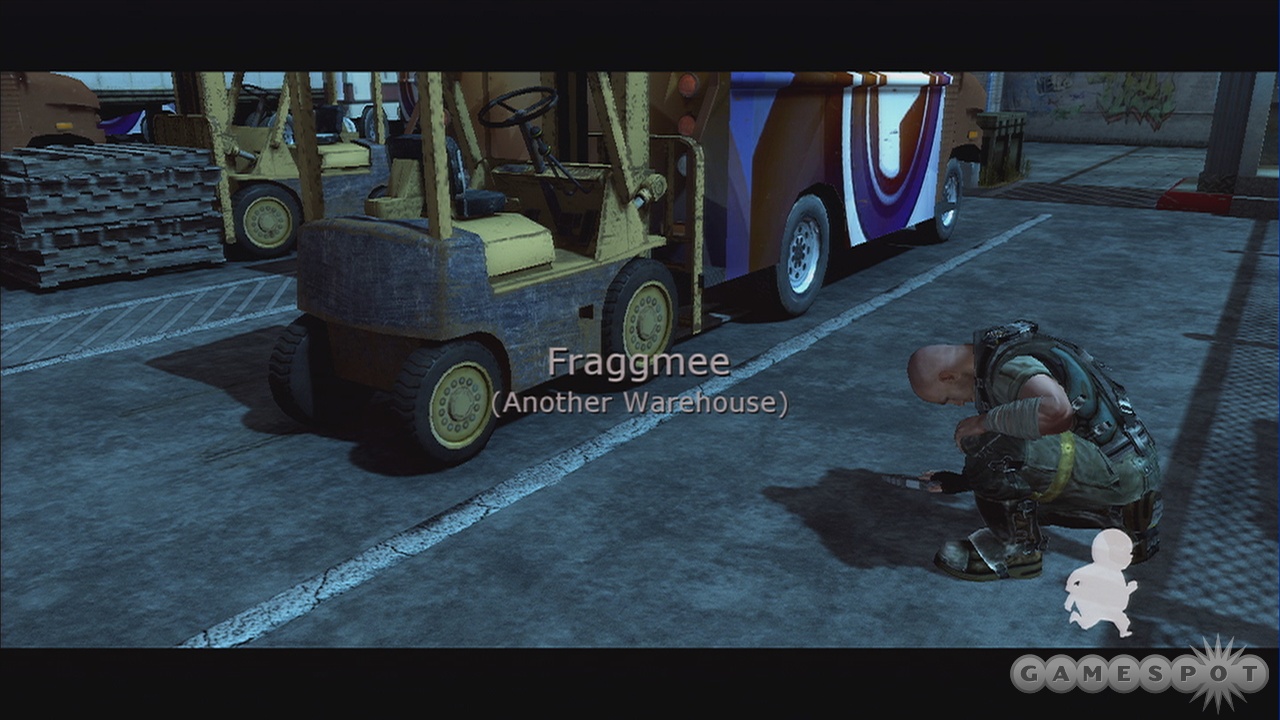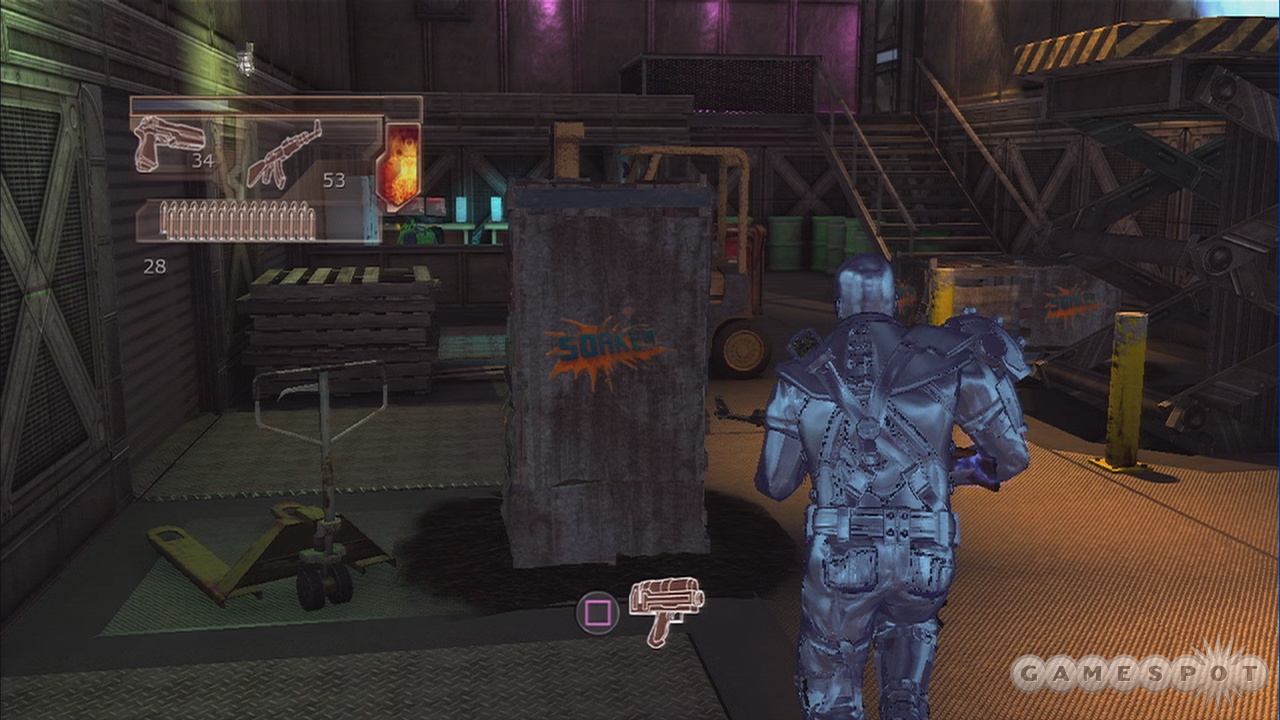Humorous games usually fall into two distinct categories. There are games that use jokes to complement the core experience, enhancing the already solid gameplay with clever jabs to lighten the mood. And then there are games that rely completely on jests to provide entertainment, hoping that the humor is strong enough to cover for a largely mediocre play experience. Unfortunately, Eat Lead: The Return of Matt Hazard falls into the latter category. Although chuckle-worthy observations are dropped at a frequent rate, the actual combat is not up to par. The game constantly points out the foibles of other popular entries in the genre, but it does so by making you jump through the same arduous hoops, which makes for less-than-thrilling action. Eat Lead is funny enough to cover for some of its many missteps, but you'll have to stomach bland level design, nonexistent enemy AI, and downright cheap boss fights to enjoy Matt Hazard's uneven "return" to gaming.

Matt Hazard is the self-aware star of his own video game. He was once a prominent figure in the industry, but after using his well-known face to cash in on a number of questionable spin-offs, he quickly spiraled into obscurity. Eat Lead marks his triumphant return, but he is forced to fight for his digital life against a creator who wants to make sure that this is his last game. The story is amusing enough, poking fun at the multitude of real game characters who have overstayed their welcome through the years, but it takes itself too seriously at times. The best moments of the story happen in the opening cutscene, in which Hazard laments his decision to star in Haz-Mat Carts, and during prebattle banter against the various bosses, wherein he mocks their cheesy dialogue and stereotypical dreams to rule the world. However, the plot falters when it centers on Hazard's nemesis. These scenes are simply not funny, forcing you to patiently wait until Hazard appears onscreen once more to pull this game out of banal territory.
Matt Hazard's clever quips are able to entertain for only so long; at some point, you're going to have to actually play. Eat Lead feels very similar to Gears of War. The cover system lets you hunker down behind objects until enemies carelessly peek around corners, and it feels really good here. You snap behind barriers with ease, and you can quickly and smoothly get out when enemies flank you. There are a few twists to the classic formula as well. First of all, your fortifications can be destroyed, which means that you won't be able to stay in one place for the entirety of battles. Furthermore, you can aim at nearby objects and push a button to immediately run to them, which makes it painless to move positions in midfight. Although your arsenal is limited, the included guns usually pack a punch. Nailing an enemy in the head with a magnum from across the screen is satisfying, and shooting a grenade into a group of closely packed zombies results in a glorious explosion of flopping rag-doll bodies.
When Eat Lead is clicking, the combat is really fun and plays like a faster, bloodless version of Gears of War. But its reliance on parody means that the game frequently stumbles. The level design is bland and uninspired, shepherding you from one forgettable warehouse to another. Although the layouts do an adequate job of poking fun at other games, the formula quickly gets old. Battles are usually staged in large environments with pieces of cover liberally sprinkled around, which makes for a repetitive experience. Hazard jokes about predictable enemy placement and ambushes that never surprise, but just because he is aware of the sloppy level design doesn't mean that it's actually fun to continually play through the same tired cliches.
Your enemies are sorely lacking in intelligence, exhibiting only two different maneuvers in combat. During most fights, enemies will stand behind cover, giving you time to meticulously line up their noggins in your sights for a quick death. At other times, they will rush at you, which borders on cheap because Hazard is not well equipped to handle close encounters. Enemies also frequently spawn directly behind you, which can lead to unanticipated deaths if you don't hear them teleport in. At least the enemies you fight are funny. One level has you rescue a green-clad soldier named Master Chef while you mow down a horde of the often-mocked space marines. When you finish one off, you tauntingly yell, "Semper die!" In another level, you battle enemies from a water-based shooter called Soak 'Em, and they shout "Damp if you do, damp if you don't" when you duck behind cover.

The boss fights are as amusing as the enemies, but finishing them can be cheap and frustrating. You battle one sniper boss on three separate occasions, and his instant-kill gun will lead to repeated failure until you figure out his pattern. Other bosses summon a never-ending horde of enemies that you must fight off while you try to pepper the main baddie from afar. Despite these problems, these encounters are still enjoyable because of the delightful dialogue beforehand. During one memorable scene, you square off against a character pulled straight from a generic role-playing game. The typical cliches are here--flamboyantly dressed villain spouting meandering statements with an overabundance of ellipses--and Hazard frequently points out his enemies' annoying quirks.
The music in Eat Lead uses the cheesy allure of '80s rock to energize the experience. The standard theme continues throughout the game, and its catchy synthesized riff is enjoyable and hummable. Although it surfaces again and again throughout the game, it fits the mood perfectly and never gets old. Various motifs also sprout up to complement the theme of each level. The two-dimensional Waferthin troops come with their own German-inspired music, and another nice touch is the Japanese tune when you're shooting up a sushi restaurant. The music is a standout; combined with Hazard's many memorable quips, it provides the backbone for this otherwise uninspired game.
Eat Lead's reliance on parody is a detriment to its game design. The repetitive levels and cheap enemy encounters hold back what is a fundamentally sound shooter. But though the gameplay frequently stumbles, the humor is able to rise up in its place, which makes the experience more enjoyable than the lackluster action promises. With no multiplayer mode, cooperative play, or hidden goodies waiting to uncover, replay value is extremely limited, but it takes about 10 hours to play through the campaign. Despite its problems, Eat Lead is still a fun game, but its jokes will never make you forget about its many missteps.